SaaS content writing is at the core of our marketing services at Grow and Convert. In the past 6+ years running our content marketing agency, we’ve worked with dozens of SaaS businesses and produced hundreds of pieces of SaaS content for our clients.
Through these experiences, we’ve become intimately familiar with:
- Writing SaaS content that actually drives business results (i.e. actual leads and product signups from readers).
- Identifying mistakes when writing SaaS content that produces minimal business value.
In previous articles, we’ve written about problems with the way most companies approach their content marketing strategy and how we approach it differently. In this article, we’re going to focus on the content writing process itself.
So, whether you’re interested in hiring a SaaS content writer, or you want to become a better SaaS content writer yourself, this post will teach you the mistakes to avoid and how to produce content that drives leads and signups.
Specifically, we’ll share:
Before we wrap up, we’ll also share opportunities to learn more about our strategy and process in our course, work with us as a content writer, or hire our content marketing agency to produce content for you.
Now, let’s begin by covering the biggest issues we see in how most SaaS companies and writers produce SaaS content.
Key Problems with the Typical Approach to SaaS Content Writing
We see four key problems with the way most companies approach SaaS content writing:
- Content creation is exclusively focused on top of funnel (i.e. non-purchase intent) topics.
- They hire freelance writers and expect them to become subject matter experts by themselves.
- They write generic blog introductions that cause readers to immediately bounce.
- They think it’s taboo to sell their product in their content.
First, we’ll dissect each of these problems, then, we’ll share our content writing process and explain how it solves each problem.
Problem #1: They Write Exclusively on Top of Funnel Topics
Yes, this is actually a content strategy problem as it’s about the topics and SEO keywords that companies choose to write about, not the actual writing itself. And as we linked to above, we’ve written extensively about this problem.
In short, the majority of the content marketing universe goes after high search volume, introductory, top of funnel topics. We do the opposite: we start keyword research for our clients at the bottom of the funnel — targeting search terms we think that “ready to buy now” customers would Google. Why? Because they convert way better than top of funnel posts.
We have to talk about this first because choosing to write on top of funnel, introductory topics is the “original sin” issue that’s the source of so many of the other SaaS content writing issues we discuss below.
Namely, because SaaS companies write on top of funnel topics, their content isn’t closely related to their product, so they see no need to have their own company and product experts inform the content. They fully outsource content to freelance writers (discussed next) and expect them to be solely responsible for coming up with all of the ideas and advice in the content. As a result, writers end up producing long-form content that’s undifferentiated from everything else that’s already out there.
For example:
- The CRM company focused on SMBs producing yet another “Guide to sales outreach” that won’t teach an experienced sales leader anything they don’t already know.
- The project management SaaS company producing a post on “tips to increase productivity” that gives cliche advice like creating to-do lists and setting deadlines.
- The marketing analytics SaaS company producing an “industry trends” article discussing obvious trends like the importance of mobile optimization or SEO.
Companies like these would see much higher conversion rates by first going after SEO keywords like “best CRM for small business,” “project management tools,” or “marketing analytics software for agencies.”
So this is the first problem: Writing on beginner-level, top-of-funnel topics, which naturally leads to a writing process where freelancers are asked to be subject matter experts on the topic. The solution is to write on product-focused bottom of funnel topics. But, in order to write these product-specific pieces, you need a process for arming writers with knowledge about your product’s unique features, value props, and differentiators. This leads us to Problem #2.
Problem #2: They Try to Fully Outsource Content Creation to Freelance Writers
We’ve written at length on why fully outsourcing content to freelancers is flawed. This practice is a symptom of the top of funnel problem we discussed above.
When companies view blog content as just a way to engage target audiences with miscellaneous topics that loosely relate to their industry, they assume it’s sufficient to allow (or even expect) freelance writers to create that type of content on their own.
As a result, companies tend to do one of the following:
- Find keywords using SEO tools like Ahrefs or Semrush and ask writers to self-research a piece.
- Hand writers a content brief, then ask them to do the rest.
- Have the writer source outside experts for the piece.
In our experience, regardless of how good a freelancer’s writing skills might be, this is a recipe for producing unimpressive, undifferentiated content. Namely, because it has one fatal flaw: Freelance writers rarely, if ever, have mor e subject matter expertise in a product space than professionals in that space (aka your customers).
As a result, writing where freelancers try to use their own ideas on the topic typically fails to incorporate unique insights and originality that can only come from experts within the company (founders, product marketing managers, sales teams, etc.).
As we’ve argued before, expressing unique angles and ideas is critical to producing any type of content, but it becomes even more important when companies begin writing about product-centric, bottom of funnel topics because those require having detailed knowledge of product features, differentiators, and competitors.
This isn’t to say you can’t successfully work with freelance writers to produce content—you can. You just need a process like the one we describe below which allows writers to express a company’s expertise and uniqueness in their articles.
Problem #3: They Write Generic Introductions That Cause Readers to Bounce
Poor blog introductions are commonplace in SaaS content writing and in content marketing more broadly. Even talented writers have a tendency to make generic opening statements and fill introductions with “fluff” that’s so obvious to readers that they bounce almost immediately.
This is a key problem to solve because even if you have some high-quality content throughout the body of the article, it’s useless if readers don’t stick around to read it. Intros tell readers if the rest of the article is for them.
Devesh wrote a great article about this which you can find here. In it, he shares examples of good and bad blog introductions to demonstrate a) what not to do and b) a 4-step process for getting your intros right.
This is something we’re continuously teaching and working on at our agency when onboarding new writers and content strategists. We also cover this in our course.
Problem #4: They Don’t Discuss or Sell Their Product
Finally, another issue that’s related to the top of funnel problem we discussed above is that companies focus content efforts on topics that have little to do with their product, so they don’t sell (and often barely mention) their product in their content.
They tend to think that it’s somehow taboo to sell their product and that content is strictly for earning trust and generating brand awareness.
But if SaaS businesses want to see actual ROI from their content marketing, they need to adopt the perspective that it’s okay to sell their product through their content. And this is true for both bottom and top of funnel topics.
While our strategy is primarily bottom of funnel-focused—i.e. writing about topics where discussion and selling of the product is expected—we increasingly find that top of funnel content can also convert really well when the product is incorporated thoroughly and in the right way. Our recent case study on scaling content has some great examples of this.
By following the process we lay out below, SaaS businesses and content writers can solve each of the problems we’ve described throughout this section.
Our Process for SaaS Content Writing That Drives Leads and Signups
Our agency’s SaaS content writing process can be broken down into the following steps:
- Choosing Topics and Keywords: Coming up with content ideas and identifying target keywords that have business value.
- SERP Analysis: Analyzing the search engine results page (SERP) for each of those keywords to understand which topics need to be covered in an article for it to rank.
- Content Interviews: Interviewing subject-matter experts within the company about that topic.
- Determining Article Type and Structure: Deciding on the type of post we’ll create and designing the structure of an article based on the SERP analysis, interview, and article type.
- Writing: Drafting the content in a way that fills in that structure with compelling information to sell their product or service.
- Editing and On-Page SEO: Doing article revisions and polishing off content with on-page SEO.
We’ll discuss how we approach each step below. We’ll also provide examples and links to past articles for further demonstration of how these steps can be done.
Step 1: Choosing Topics and Keywords
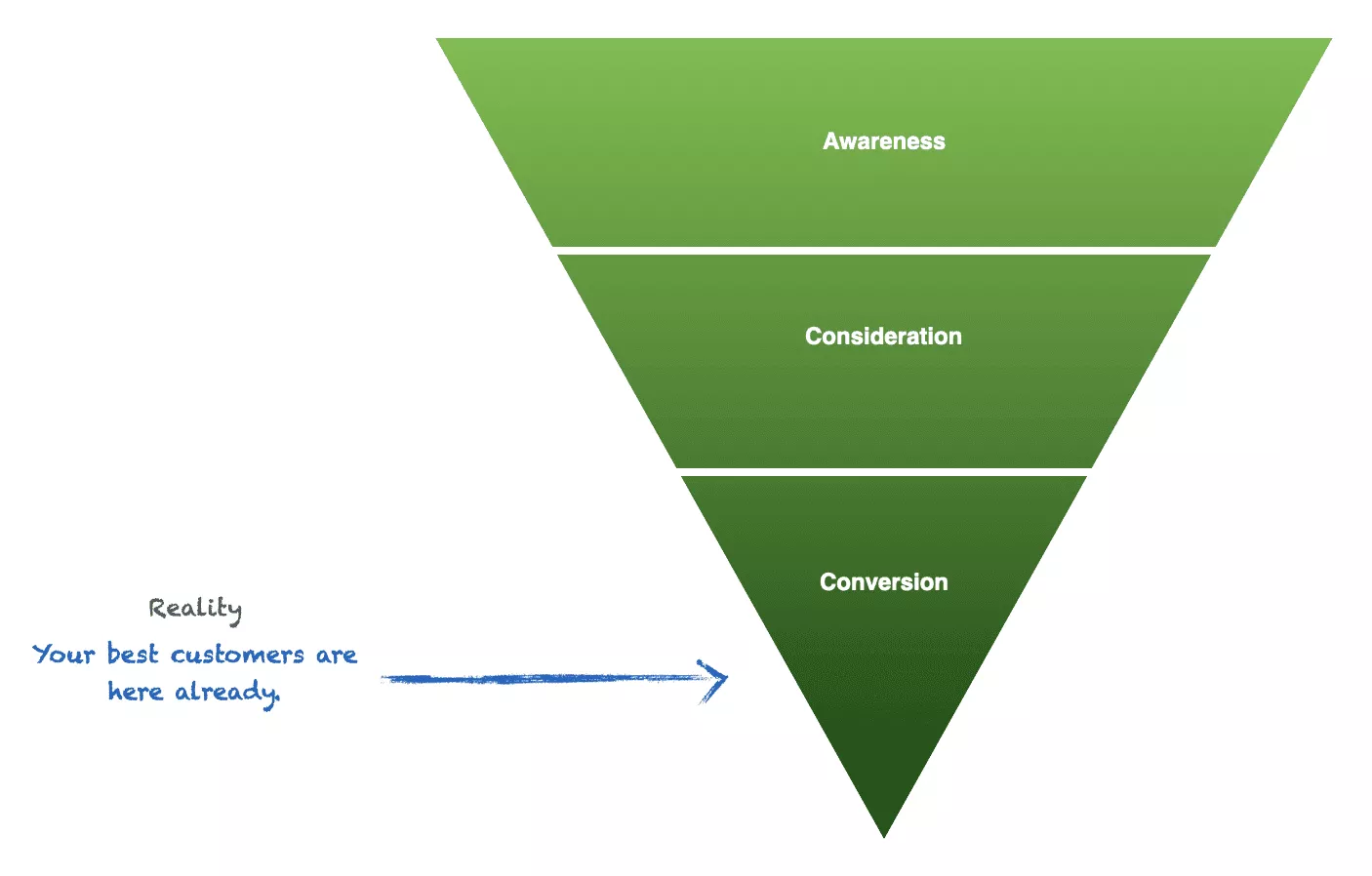
Above we discussed and shared an article describing our SaaS content strategy on a theoretical level (i.e. why we start with bottom of funnel topics, and work our way up the funnel).
But what does that look like in practice? And how does it tie into the actual SaaS content writing process?
Our follow up article to that original piece goes into this at length. In it, we cover:
- The specific types of keywords we choose and content we create for our SaaS clients (categorized by bottom of funnel, middle of funnel, and top of funnel topics).
- Tons of examples of live articles we’ve written for clients that you can go and read, find ranking in Google Search, and use as inspiration to build your own equivalent content (following the structures used in those articles).
- The mix of content that we typically prioritize for our SaaS clients in the first 3 months of an engagement.
Some examples of the types of keywords we go after include:
- Top/best keywords: e.g. “best [use case] software”
- Software category keywords: e.g. “[Industry] + [Use case] software”
- Comparison keywords: e.g. “[your brand] vs. [competitor]”
- Alternatives keywords: e.g. “[competitor] alternatives”
The key thing to note about these topics is that as we mentioned above, they’re very product-centric. In contrast to top of funnel topics that may not have a clear product tie-in, these necessitate discussing product details and differentiators.
This is why our client onboarding process involves in-depth customer research interviews (which we’ve written about here and here), getting product demos so we can accurately describe features in detail, and also doing interviews for individual articles, as we’ll discuss below.
Step 2: SERP Analysis
There’s an argument to be made that the SERP analysis is one of—if not the most important step of our writing process after keyword selection.
This is because:
(A) It’s fundamental for understanding search intent and the topics that need to be covered to rank for a given keyword.
(B) If content doesn’t rank for its intended keyword, it won’t matter how well it’s written because it won’t have the steady flow of organic traffic that it takes to sustainably produce conversions over the long-term.
We’ve written about our process for performing a SERP analysis in our article on SEO content writing. It can be summarized in the following steps:
- Review the titles, page types, and sources of existing page one results: Titles and page types reveal the types of content ranking for your keyword. For example, are there a lot of list posts, “how to” articles, guides, landing pages, or something else? In general, what is ranking tells you what Google already thinks is best for this keyword, so the safe option is to use one of those content types for your piece of content. But that’s not a hard and fast rule. If we feel we can better meet search intent with another type of content, sometimes we’ll try it. We’ll also note the sources of the top results to understand who we’re competing against (e.g. Direct competitors? News sites? Adjacent products and services? etc.). The point is to know exactly what the existing results are doing and be intentional about what content type we’ll use.
- Review the topics discussed inside of those posts or pages, and identify themes or topics that come up repeatedly: We scan or read each of the results on the first page and pay attention to topics that are discussed (especially those listed in subheadings) throughout the page. As we go through the results, we’ll take note of topics that come up frequently. This indicates that they likely need to be covered in our post in order for it to rank.
- Identify what individual pages or articles do well and what they do poorly: Understanding the strengths and weaknesses of existing top results allows us to incorporate elements that we think work well, and gives us insight into the ways in which we can differentiate our post to create a better piece of content.
- Determine the intent(s) of searchers typing in this term: Once we’ve gone through the results, we’ll summarize the core intent(s) of the users searching this keyword. This works as a reference point as we create our article, allowing us to ensure we stay on track for satisfying that intent.
In the article referenced above, we walk through a detailed example of how this is carried out in practice. Specifically, we explain how we approached a SERP analysis for the keyword “paid search dashboard” for our client TapClicks.
Step 3: Content Interview
In addition to our customer research process mentioned above, we often conduct interviews with our clients for the individual articles that we produce.
This is absolutely essential for:
- Covering necessary topics thoroughly (i.e. the topics we need to cover in order to rank in the desired SERP).
- Finding unique angles or points of originality to include in the post.
- Ensuring we highlight the most relevant and compelling features of the product for that given topic.
Based on our SERP analysis, we’ll craft a series of interview questions. Typically, this will include a mix of questions about:
- Pain Points: What challenges or problems does their target customer face regarding the topic we’re covering?
- SERP Topics: What is the company’s perspective on what readers should know or understand about the sub topics that need to be addressed in order to get the article to rank?
- Product Solution and Differentiators: What are the specific ways in which their product solves the corresponding customer pain points? And how does it do so differently or better than competing solutions?
We’ll typically have a 30-45 minute call with whoever at the company is the best person to speak with on that topic. And with SaaS clients, we’ll often talk to several people for a single article.
For example, we may talk to an in-house industry expert to learn about the pain points of customers, and then speak separately with a product manager to get a detailed walkthrough of how the product solves those pain points.
The bottom line is that we tap into the expertise of people at our clients’ companies for every article we write. We communicate their perspectives and insights. We don’t regurgitate what other people are saying on the topic.
Step 4: Choosing the Article Type and Structure
In SaaS content writing, different categories of keywords call for different types of articles which are closely linked to the way an article is structured (i.e. the order in which subheadings or subtopics are presented in an article).
For example, when targeting “top/best” or “alternatives” keywords, you’ll tend to see that the top ranking content is presented in a list format. This makes sense when you consider the intent of people searching terms like “best accounting software” or “QuickBooks alternatives.” They want to view options, so a list-style post is often the best way to satisfy that search intent.
And list posts are exactly what we see when we type these terms into Google:
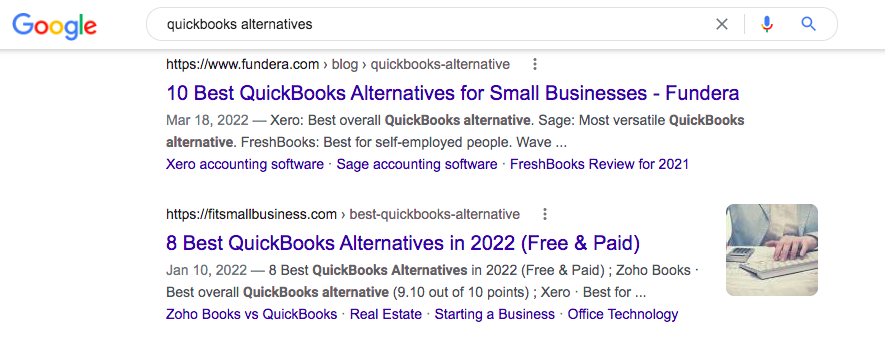
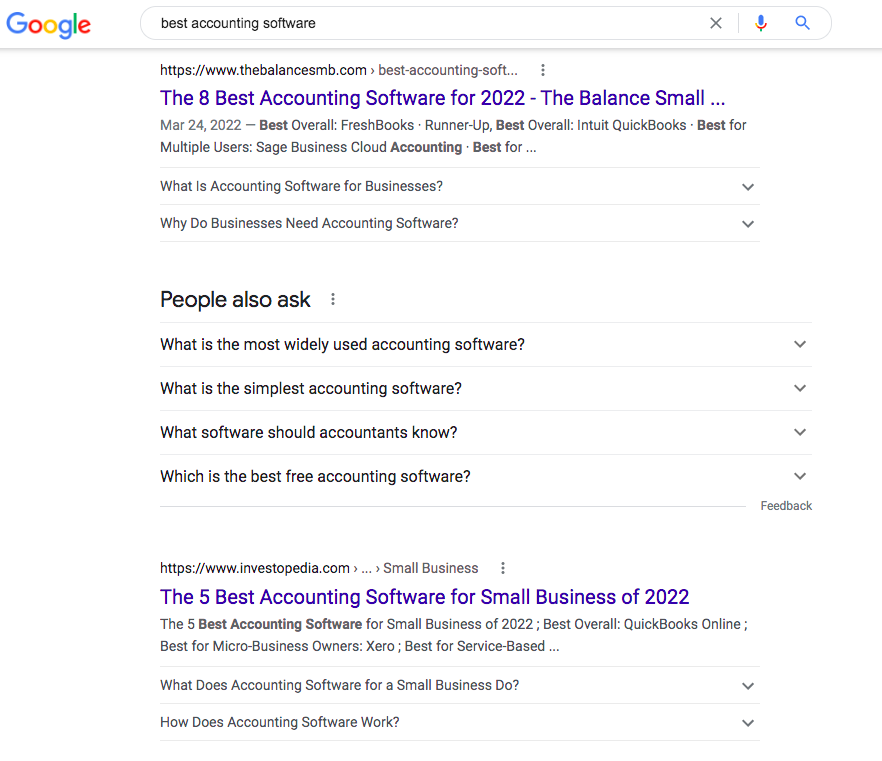
So, if we’re targeting a top/best or alternatives keyword, we’ll often create a list-style post because—as Bernard Huang of Clearscope has pointed out to us—that’s what Google is telling us will be the best match of search intent.
In that case, we’d structure the subheadings of our article as a list, determine which competing solutions to include, how to make the list different or more useful than other top results, and so on.
Alternatively, if we’re targeting a “how to” query, more than likely we’ll find “guide” articles or “step-by-step” instructional pieces in the top results. In that case, we’d usually choose one of those article types and structure our article accordingly.
Additional Notes on Structure
When we refer to an article’s “structure,” we’re specifically referring to the subtopics you’ll discuss in a piece of content, each defined by a subheading (e.g. H2, H3, H4, etc.), and the order in which they’ll be presented.
Subheadings are key in SaaS because people don’t read SaaS blog posts word for word like a Harry Potter novel, they scan. Especially for bottom of the funnel terms like “best X software”. Readers look for particular features they care about and zoom in to read in detail. So it’s important to be intentional about using subheadings accordingly.
Generally, we’ll decide on what each subheading will cover before we begin filling in the content of an outline and actually writing an article.
Here are three additional notes on article structure to consider:
1. Article Structure Should Include SEO Topics Needed to Rank
In addition to structuring articles based on the type of article we’re creating (e.g. list, how-to guide, etc.), we’ll also consider and include relevant SEO topics when necessary.
For example, if we found in our SERP analysis that a particular topic showed up over and over again, like “templates” or “integrations”—we might choose to incorporate a subheading that covers that into the structure of our piece.
2. Article Structure Can Be Used to Differentiate Your Post
A simple example of this is breaking down a list article into categories that make it more useful to the reader. So, for our “best accounting software” example, we might categorize our list by business size (SMBs, enterprise, etc.), industry, or use case.
In doing so, we can a) differentiate our article from other posts which may be uncategorized lists and b) make our post more useful or easy to navigate for readers, which can help with rankings.
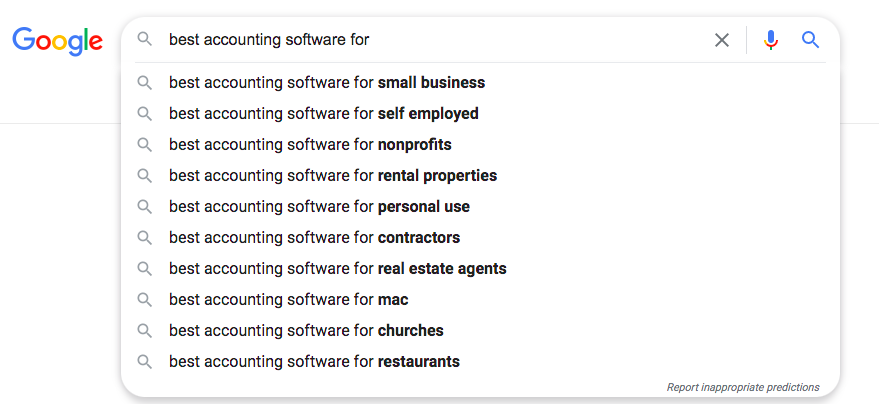
3. Article Structure Should Include Sections Dedicated to Describing Your Product
As we described above, SaaS content needs to discuss your product. Generally this means including one or more sections in the structure of an article where we’ll focus on the product, how it solves customer pain points, how it’s different from competitor solutions, etc.
Step 5: Writing
Only once all of this setup work has been done do we begin the first draft of a piece. When it comes time to write, we focus on the following:
- Getting the intro right.
- Incorporating specificity or originality.
- Being detailed and backing up statements with compelling reasoning.
- Selling the product.
Let’s look at each.
1. Getting the Intro Right
Again, Devesh wrote an entire post on this, which you should read here. In that article, he recommends a 4-step process for writing better blog intros which involves:
- Thinking clearly about who the target persona is that you’re speaking to. This will help give you perspective and (hopefully) avoid speaking to a career sales veteran like a first year sales rep or college student.
- Thinking of how they are encountering your post (i.e. did they get there via search engine or social media?). If your post targets the keyword “best project management software,” and it’s intended for people who are typing that query into search, you probably don’t need to spend time in your intro discussing what project management software is. The people searching that likely just want to know what options exist and which one is best for them. If you communicate to readers upfront that that’s what you’re going to help them figure out in the article, they’ll be much more likely to stick around and actually read it.
- Thinking about what makes your post specific or original. This is the hard part. It will force you to answer some tough questions. Namely, is there anything specific and original about your post or is it the same old content everyone else writes? If it’s the latter, you’ll have trouble writing a good introduction.
- Picking one or more angles of specificity or originality to start the post with. Getting straight to the point and not wasting time with questions or other background filler.
For examples of how we approach SaaS intros in practice, check out this post which links to a bunch of pieces we’ve written for SaaS clients. Read the intros and you’ll see themes and get the gist of how we approach them. Namely, we try to be direct, specific, speak to pain points, and share what we’ll cover in the post to entice the viewer to keep reading.
2. Incorporating Specificity or Originality
We’ve written two past pieces on our ”Specificity” and ”Originality Nuggets” strategies. We define (and differentiate) them as:
- Specificity Strategy: Wherever possible, speaking to very specific points and topics, rather than general ones. This can relate to the topic of the article itself, or to the subtopics that are discussed within an article.
- Originality Nuggets: Little bits of originality that make a piece of content unique from others, regardless of whether it speaks to specific or general topics.
Here are a few SaaS content examples that demonstrate these:
Specificity Examples
- How to Plan the Shortest Route for Multiple Destinations in Google Maps: This is an article we wrote for our client Circuit, a delivery route planning software. This demonstrates specificity at the article topic level: “shortest route for multiple destinations in Google Maps” is a highly specific query indicating someone has a specific pain point that Circuit solves. In the article, we walk through the limitations of Google Maps for routing multiple destinations, and explain how Circuit makes this easier.
- Plumbing Pricing Guide: How to Price Plumbing Jobs for Profit: This is an article we wrote for our client ServiceTitan, a trade contractor software. This demonstrates the specificity of topics discussed within an article, even for a general topic like “plumbing pricing.” We cover specifics like why plumbers should use flat-rate pricing, why they should base price on process (not competitors), and specific elements they need to include when calculating price. We also walk through how their product helps facilitate each of these things.
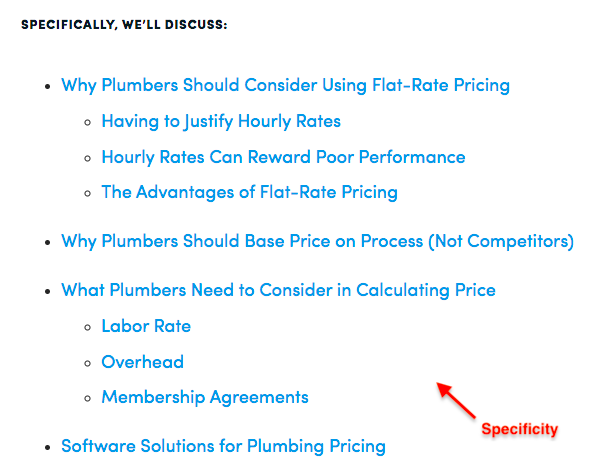
Originality Examples
- Enterprise Sales Software: The Three Tools Every Enterprise Sales Team Needs to Sell Effectively
This is an article we wrote for our client Bigtincan, an enterprise sales software. The angle of the post presents an originality nugget: that enterprise businesses don’t need more users in their traditional CRM, they need something else that’s designed specifically for them. It then speaks to specifics of what those needs are, and goes on to describe those within the piece.
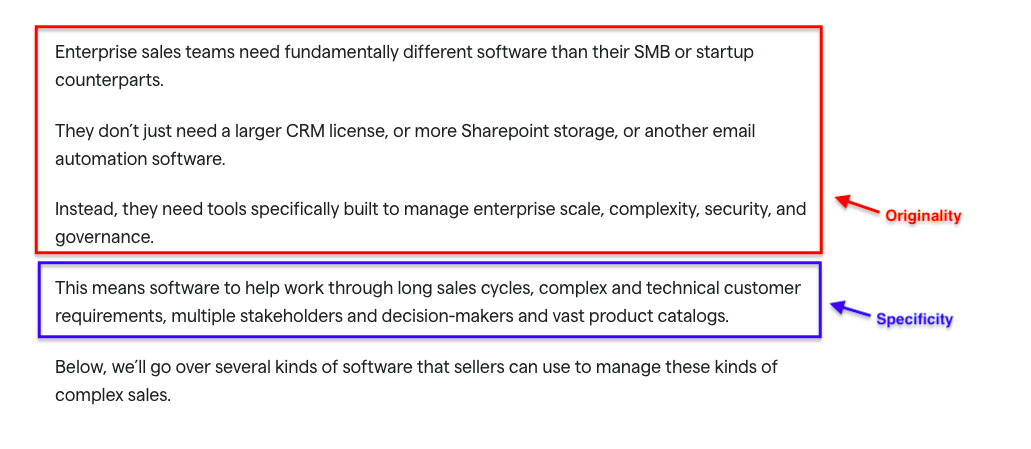
- 20+ Automated Testing Tools for Web Applications (Including Coding, Testing Management Tools, and No-code Options)
This is an article we wrote for our client Rainforest QA, a no-code tool for doing QA of web applications. It takes an original angle by breaking down a broader category of tools (automated testing tools) into three subsets of tools to help readers understand key differences between products on the market. In contrast, most articles on the topic don’t speak to these subcategories.
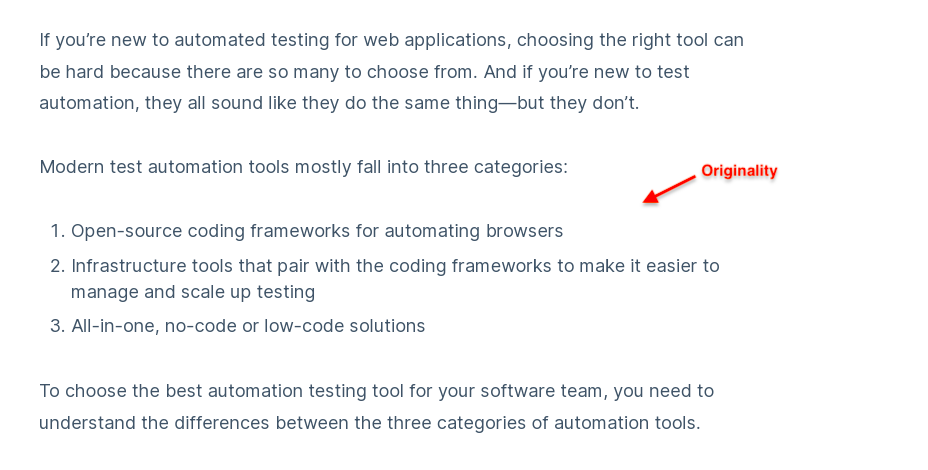
3. Being Detailed
It’s very easy when writing content to make a lot of vague statements without backing them up or explaining the reasoning behind them.
But if you want prospects reading your articles to buy into what you’re saying, being thorough and backing up what you say—whether through sharing examples or explaining why it should matter to the reader—is essential.
As we write articles, we try to avoid making vague statements by being specific, providing context, and being thorough in our explanations of things we write about. For example, consider the detail in this introduction we wrote for our client Reduct (a video editing platform) in an article targeting the keyword “video logging software”:
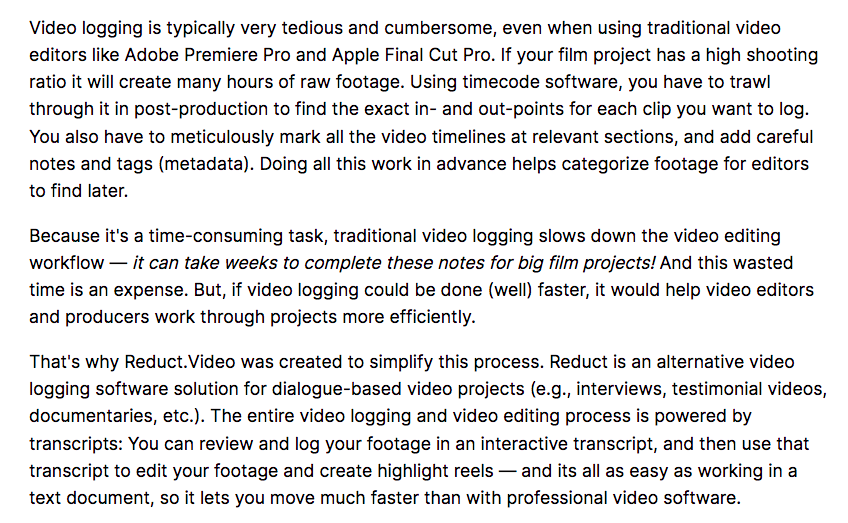
Notice how we didn’t just say, “Video logging is a very tedious process. That’s why we built Reduct to make it easier.”
Rather, we provide a lot of context that communicates to the reader we understand the tools they use, the specific challenges they face in their process, and the implications of those challenges. And then we present the solution in a detailed way, which brings us to the final key element of our writing process.
4. Selling the Product
In every piece of SaaS content we write, we discuss our client’s product and the ways in which it solves the corresponding pain points we’ve discussed throughout the article. Typically this takes the form of a product walkthrough that shows screenshots of various features, describes how they work, and explains how they solve their customers’ pain points better or differently than other solutions.
To continue with our Reduct example from above, here’s what that looked like in the video logging software article:
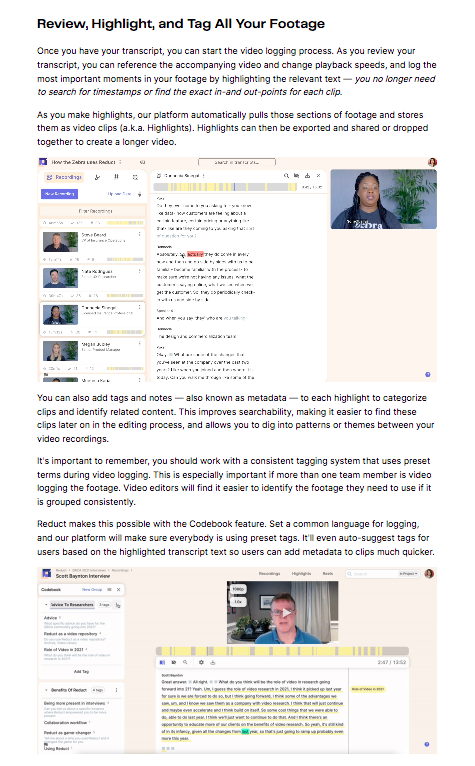
Check out that article here to read the entire product walkthrough. You can also find links to several more articles in this post to study how we approach product sections.
Step 6: Editing and On-Page SEO
The final step in our content writing process is to edit our articles and polish them off with on-page SEO. In other words, to make any necessary revisions to headings and subheadings for ranking purposes, and use an SEO tool like Clearscope to include as many relevant SEO keywords throughout the post as we can.
This is not a process of keyword stuffing. It often requires finesse and subtle decision making about which keywords to include, which to leave out, and how to get creative without sacrificing content quality.
Check out our SEO content piece for more detail on how we approach on-page SEO.
A Note on Using This Method, Doing It with Us, or Hiring Us to Do It for You
If you’re a freelance writer with SaaS clients or you want to work with SaaS clients, you can use the strategy and process that we’ve discussed throughout this post. You can pitch this to clients or potential clients as a way for them to get more leads from content.
Our course can teach you this process in greater detail and you can go forward and carry this strategy out for companies on your own.
Alternatively, if this style of SaaS content marketing appeals to you, consider joining our content marketing team as a writer or content strategist. We have awesome clients. We’re a remote company. We pay well. And you won’t have to stress about getting your own clients or spend a bunch of time doing outreach to get them.
Lastly, if you’re a SaaS business that’s looking for writing services, you can hire our agency to do content marketing for you. Learn more about our service and pricing here.
Questions or comments about anything we’ve discussed in this article? Please share them in the comments below! We’d love to hear from you.








